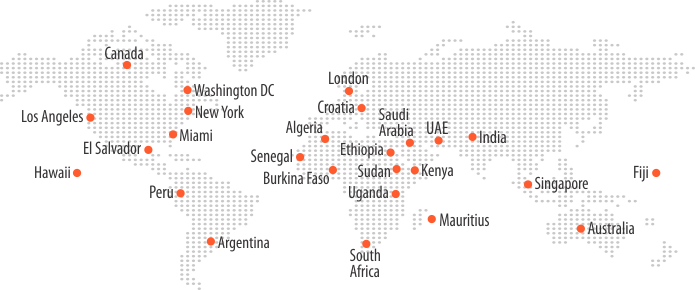VoIP Termination Issues: What They are and How to Prevent Them

Before the arrival of VoIP (Voice over Internet Protocol) to the market, all phone calls were routed through the public switched telephone network. These calls were long-distance and international, which made them pricy. As a result, most small or medium businesses could not afford to expand their reach to global markets.
But the entire scenario changed as VoIP entered the picture. With VoIP call termination, businesses of all sizes can afford to make and receive secure, high-quality international calls and connect customers worldwide.
As VoIP technology has revolutionized our work and communication, we still face issues. These issues can be significantly enhanced with the right tools and proper planning to enjoy high-quality and affordable international calling and avoid any problems arising.
In this blog, we will share some insider tips from retail VoIP service providers on ensuring your company gets the most out of your VoIP call termination service and how to avoid common problems.
What is VoIP Termination and How it Works?
VoIP termination, also known as call termination, routes phone calls from one provider to another until the call is delivered (via VoIP Voice over Internet Protocol) to the correct recipient or final destination (i.e., the end-user). The end user, or the endpoint, means the destination where the call is received; for example, it may be any phone or service such as skype or PSTN, depending on if the calling party contacts a landline number or mobile network carrier.
The voice termination provider is responsible for taking your incoming calls and routing them to their destination. They ensure that the call quality does not deteriorate and that the call is completed adequately. It is possible only with the development of VoIP technology.
How Does it Work?
Call termination transfers voice packets over the Internet rather than the public switched telephone network (PSTN). It allows for much cheaper long-distance and international calls. For example, VoIP operations transfer data into small packets from one caller to another through Wi-Fi or broadband connection. As the call reaches the destination, the packets are reassembled to form the original data to be communicated to the recipient. VoIP uses primitive technology, supporting 3g or 4g phone networks.
There is no requirement for any additional hardware devices or infrastructure. The calling party uses VoIP-compatible devices such as phones, tablets, or computers.
Common A-Z VoIP Termination Problems
VoIP call termination is an essential part of today’s business world, and there are some fundamental problems you need to be aware of to avoid them. However, with some planning and a little insider help from your VoIP provider, these issues can be easily prevented, and you can enjoy low-cost international calling. Let’s see some common problems:
- Calls aren’t reaching their final destination
- Call quality is poor
- Call terminates early
- Jitter or data packet loss
- Unable to make calls
- Echo on VoIP calls
Troubleshooting Problems of A-Z VoIP Termination
You may have experienced issues with your VoIP termination as a VoIP user. Audio issues, dropped calls, inaccessibility, and echo are a few common problems with this service. With the proper setup and some troubleshooting steps, you can enjoy reliable and affordable call quality from your VoIP provider.
VoIP termination issues can cause problems with incoming and outgoing calls, so we’ll review some common misconceptions about VoIP issues and what we can do if you notice any disruptions in your calls.
Calls aren’t Reaching their Final Destination
VoIP calls will not reach their final destinations if there is a failure in the VoIP infrastructure, customer equipment, or an issue with your provider’s network or router. So, you need to call your provider to determine what failover provisions they use. If your provider doesn’t provide the fully redundant call routing and failover provisioning, it may have to be considered for replacement.
Another resolution is that VoIP providers offer toll-free emergency services and backup Session Initiation Protocol (SIP) connections. For example, VoIP providers are expected to offer 99.99% uptime, including an easy way to place calls during an outage using a backup SIP service connection. In case you fail to do so, you can have serious consequences on businesses’ reputations and lead some customers to switch providers.
Call Quality is Poor
Internet service is the biggest concern for customers who use VoIP as a primary communications solution. For example, if you’re facing poor call quality with VoIP call termination, you need to check your internet service. You may need more bandwidth to support high call quality. Generally, depending on codecs, you’ll need approximately 85-100 kbps per concurrent call to ensure high call quality.
Codecs are defined as the size of samples that is it is responsible for compressing and decompressing voice data. Suppose the compression rate is higher, the better the sound quality. Different codecs can significantly impact bandwidth and delay, so choosing something appropriate for your business is essential. So, before switching to VoIP, ensure sufficient bandwidth is allocated.
Call Terminates Early
VoIP termination is an essential function of any VoIP solution provider. Since voice packets are transferred in small units using the Internet. These packets move in the best possible way to reach their destination with little or no loss. But sometimes, they fail to reach their destination, resulting in a high packet loss. In some cases, loss of packets may end your calls. The reason behind not reaching their destination is usually network congestion.
In this case, there are two straightforward fixes:
- Increase the available bandwidth on the network
- Prioritizing real-time voice traffic using Quality of Service (QoS) settings
Jitter or Data Packet Loss
“Data packet loss” is one of the most common VoIP issues, but on your end, it might look like poor call quality, network issues, or slow service. Jitter is an unnatural lag that occurs when data packets don’t arrive at the destination on time. It usually occurs due to congested networks causing choppy audio and packet loss, leading to poor VoIP call quality. It happens while millions of data travel simultaneously on the same IP address. A jitter buffer is a tool used to fix it by shuffling media packets and implementing a proper order for their arrival.
Check your wireless or wired setup to resolve the issue and improve call quality. To avoid glitches or poor conversation, consider wired earbuds or phones as they are corded or USB. If the problem is not with your headphones, you need to check the network as a jitter occurs due to network congestion. It would be best if you upgraded your internet connectivity through ISP. The IT department can fix this issue using a network monitoring tool by identifying the packet streams carrying VoIP data and tagging them for protection using Quality of Service (QoS) features.
For example, if you are using Dialpad, then you can check the connection:
- Open the Dialpad desktop app and select App Settings from your profile menu.
- Click “Network and Audio Connection.” A window will pop up and walk you through the steps. That’s it!
Unable to Make Calls
Dropped calls are sometimes frustrating, and it may happen that the VoIP platform doesn’t allow you to make outbound calls. The reason is completely failing to connect, or the system shows an X screen with no error message.
First Possibility: If your caller ID is banned, check it with your provider or buy a new virtual number.
Second Possibility: If your calls are dropping or not connecting, it may have two possible connected routers that drop critical data packets. So, this issue has no connection with the router configuration and is more related to the network layout. Similarly, two routers simultaneously cannot process and transmit packets due to firewalls that disrupt the internal network and VoIP traffic.
For example, some devices are processed by ALG and rewritten by firewall or NAT for better flow. This causes several VoIP problems such as being unable to make calls. It can be resolved by disabling SIP ALG and ensuring no two routers inhibit pocket flow.
Another solution is to place VoIP phones on VLAN (Virtual Local Area Network).
Echo on VoIP Calls
Echo on VoIP calls means latency. Voice packets arrive at the destination at different time intervals and sound levels, making quality-producing conversation challenging. In this problem, the receiver can only hear.
There are three causes of echo interference: Device, Bluetooth headset lag, or Network latency.
Solution for Device
Always check your device configuration first when experiencing problems with VoIP calls. Also, ensure that you are using the latest version of your device, including hardware, and perform a test of the functionality. You may also need to check any buffer that temporarily stores data.
Solution for Bluetooth Headset Lag and Network
If there is no issue with your device configuration, check your Bluetooth and try fixing the problem by adjusting the volume. Another cause of echo may be an internet connection fault. Check your network stability and run a speed test to find the bandwidth level.
Network congestion is another cause because it carries more data than it can handle. So, examine your QoS (Quality of Service) configuration on all network links in this case.
Conclusion
With VOIP, your business can benefit from the increased flexibility and lower cost of long-distance calling. International calls can be just as affordable as domestic calls. Because the Internet is truly global, you don’t need to worry about time zones or different currencies in your overseas markets.
With remote offices, mobile workers, and overseas customers, VoIP makes it easier to have point-to-point audio or video conversations than ever before. As a result, there’s an ever-increasing need for international calling solutions.
Related Posts
10 Essential Questions to Ask Before Buying VoIP Services
The Emergence of VoIP, Its History, and What the Future Holds






